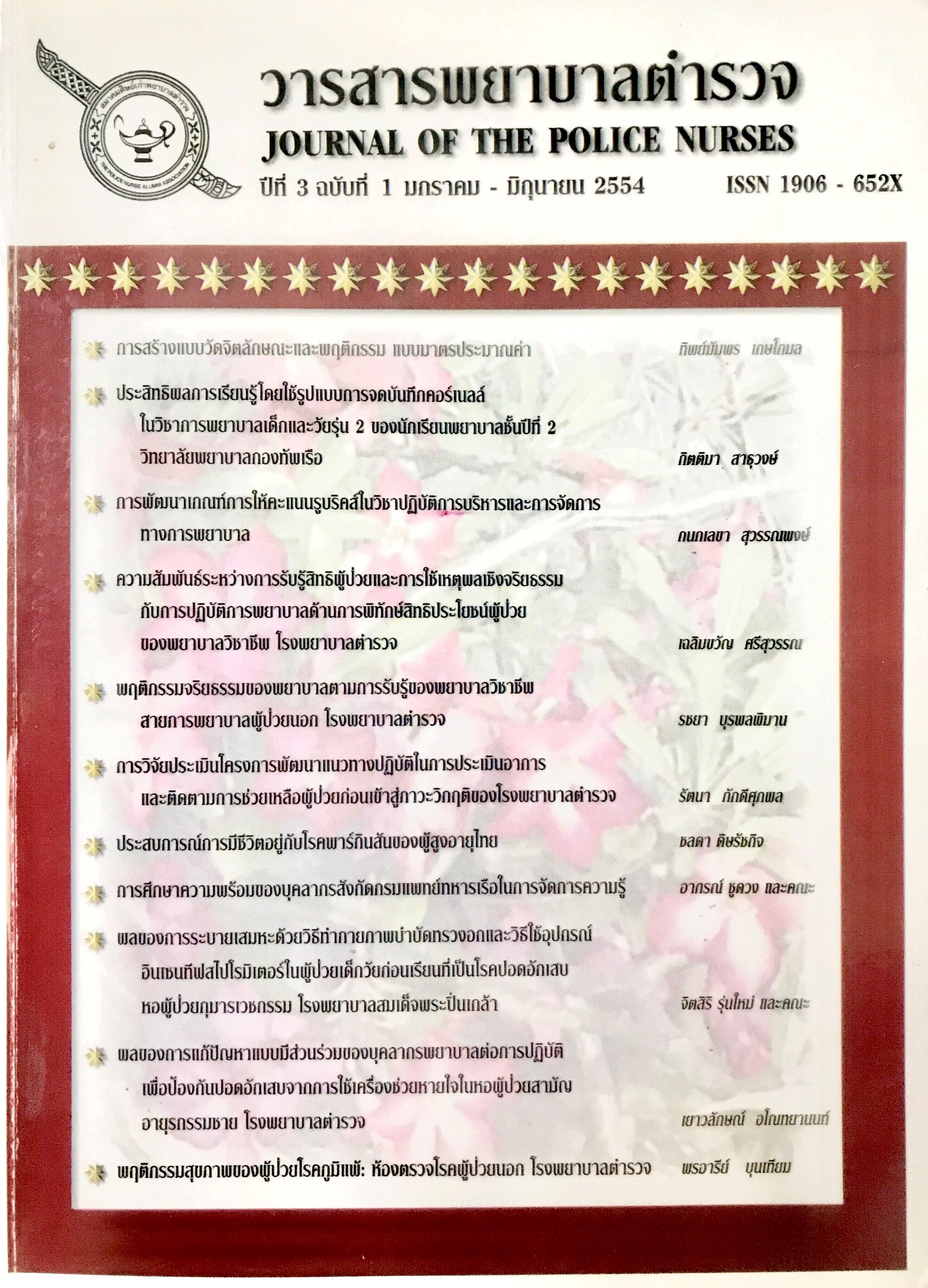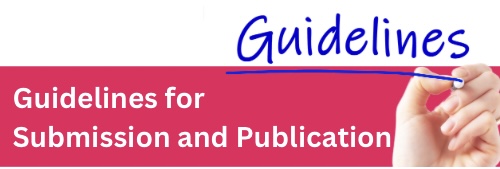ผลของการแก้ปัญหาแบบมีส่วนร่วมของบุคลากรพยาบาลต่อการปฏิบัติเพื่อป้องกันปอดอักเสบจากการใช้เครื่องช่วยหายใจในหอผู้ป่วยสามัญอายุรกรรมชาย โรงพยาบาลตำรวจ
Keywords:
ปอดอักเสบจากการใช้เครื่องช่วยหายใจ, กิจกรรมการพยาบาล, การแก้ปัญหาแบบมีส่วนร่วม, ventilator-associated pneumonia, nursing, problem-solvingAbstract
บทคัดย่อ
การวิจัยเชิงปฏิบัติการนี้มีวัตถุประสงค์เพื่อศึกษาผลของการแก้ปัญหาแบบมีส่วนร่วมของบุคลากรพยาบาลต่อการปฏิบัติเพื่อป้องกันปอดอักเสบจากการใช้เครื่องช่วยหายใจ ในหอผู้ป่วยสามัญอายุรกรรมชาย โรงพยาบาลตำรวจ โดยเปรียบเทียบระหว่างก่อนและหลังการแก้ปัญหาแบบมีส่วนร่วม ระหว่างวันที่ 1 มกราคม 2551 ถึง 31 มีนาคม 2553 กลุ่มตัวอย่างที่ศึกษาเป็นบุคลากรทุกระดับที่ปฏิบัติงาน ประกอบด้วย พยาบาลวิชาชีพ 24 คน และผู้ช่วยพยาบาล 4 คน เครื่องมือที่ใช้ในการวิจัยประกอบด้วย แบบบันทึกการสังเกตการปฏิบัติของบุคลากรพยาบาล พัฒนาจากแบบบันทึกการสังเกตของ นางสาวนัชชา เสนะวงศ์ โดยแบบบันทึกการสังเกต แบ่งเป็น 5 หมวด ได้แก่ 1) การดูแลความสะอาดช่องปากและฟัน 2) การดูแลจัดท่านอนและการพลิกตัว 3) การดูแลให้ได้รับอาหารทางสายให้อาหาร 4) การดูดเสมหะ และ 5) การดูแลท่อทางเดินหายใจและส่วนประกอบของเครื่องช่วยหายใจ และแนวทางการสนทนากลุ่ม วิเคราะห์ข้อมูลโดยใช้สถิติเชิงพรรณนา ทดสอบค่าสัดส่วน 2 กลุ่มด้วยสถิติซี และสรุปเนื้อหาจากการสนทนากลุ่ม
ผลการวิจัย พบว่า หลังการแก้ปัญหาแบบมีส่วนร่วมในเดือนที่ 1 กลุ่มตัวอย่างมีการปฏิบัติตามหลักการป้องกันปอดอักเสบจากการใช้เครื่องช่วยหายใจมากกว่าก่อนการแก้ปัญหาแบบมีส่วนร่วม อย่างมีนัยสำคัญทางสถิติที่ระดับ 0.01 โดยเพิ่มจากร้อยละ 57.64 เป็นร้อยละ 85.40 และเพิ่มเป็นร้อยละ 91.36 หลังการแก้ปัญหาแบบมีส่วนร่วมในเดือนที่ 2 โดยกลุ่มตัวอย่างที่ศึกษามีการปฏิบัติตามหลักการเพิ่มขึ้นทุกหมวดกิจกรรม คิดเป็นร้อยละ 86.70 – 95.80 การดำเนินการติดตามผลการเฝ้าระวังอุบัติการณ์การเกิดปอดอักเสบจากการใช้เครื่องช่วยหายใจ หลังการแก้ปัญหาแบบมีส่วนร่วม 1 เดือน และ 2 เดือน เท่ากับ 6.62 ครั้ง ต่อ 1,000 วันที่ใช้เครื่องช่วยหายใจ ลดลงจาก 8.82 ครั้ง ต่อ 1,000 วันที่ใช้เครื่องช่วยหายใจ หลังจากติดตามการเฝ้าระวังอุบัติการณ์การเกิดปอดอักเสบจากการใช้เครื่องช่วยหายใจ หลังการแก้ปัญหาแบบมีส่วนร่วม 1 ปี และ 2 ปี พบว่า อุบัติการณ์การเกิดปอดอักเสบจากการใช้เครื่องช่วยหายใจ เท่ากับ 6.78 และ 4.42 ครั้ง ต่อ 1,000 วันที่ใช้เครื่องช่วยหายใจ ตามลำดับ
Effects of Participatory Problem-Solving Among Nurses on Preventive Practices of Ventilator-Associated Pneumonia in Medicine Unit of The Police General Hospital
Abstract
The objective of this action research was to investigate the effects of participatory problem-solving among nurses on preventive practice of ventilator-associated pneumonia (VAP) in the medical patients of the Police General Hospital from January 1, 2008 to March 31, 2010. The participants consisted of 24 nurses and 4 practictional nurses working in the general medicine unit. Research instruments included an observational checklist record form and discussion guideline which were developed from Natcha Sanavong. The observational checklist record form was divided into 5 parts: mouth care, position and change of position, enteral feeding care, suctioning and caring for the artificial airways and ventilator equipment. It was examined by experts for content validity. Data was analyzed by descriptive statistics, and Z-test while the data collected form focus group discussion was summarized.
The results of this study showed that after participating in problem-solving strategies, the participants significantly improved their preventive practice of VAP (p<.01). The improvement was statistically significant from 57.64 % to 85.40 % in the first month and to 91.36 % in the second month. Compliance with guidelines among the population was increased in all practice categories from 86.70 % to 95.80 %. The incidence of VAP decreased from 8.82 cases/1,000 ventilator-days to 6.62 cases/1,000 ventilator-days in the first and the second month after the strategies. After participating in problem-solving strategies in one year and two years, the incidence of VAP were 6.78 and 4.42 cases/1,000 ventilator-days, respectively.
Downloads
Downloads
How to Cite
Issue
Section
License
ผลงานที่ได้ตีพิมพ์แล้วจะเป็นลิขสิทธิ์ของวารสารพยาบาลตำรวจ















